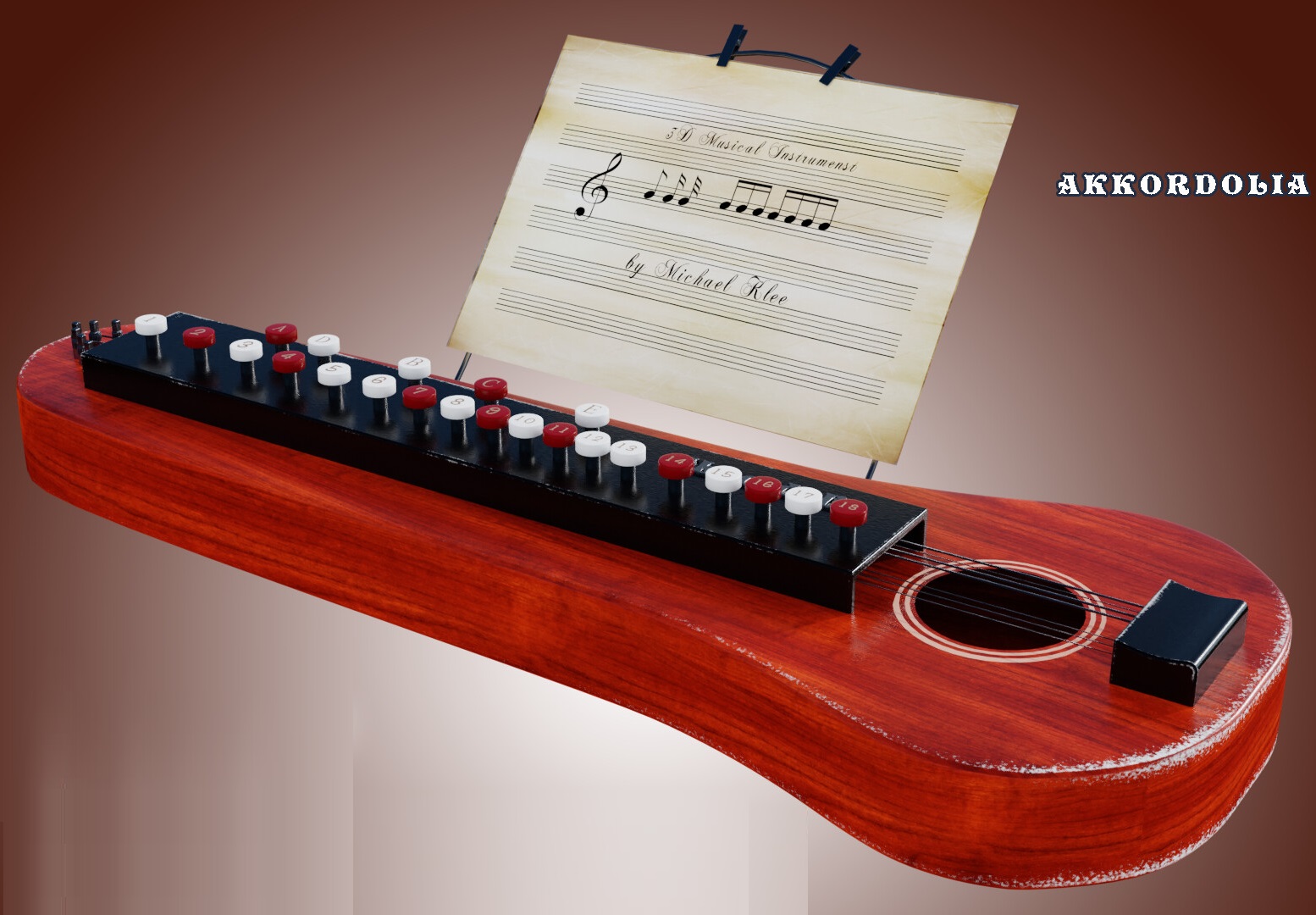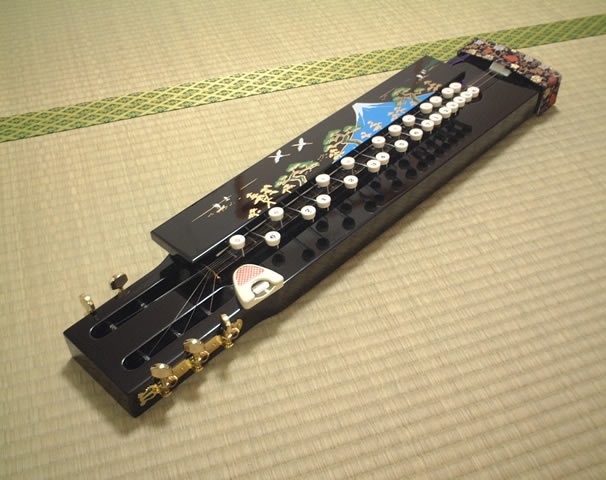Akkordolia
Keyboard Instruments
Europe
Between 1001 and 1900 AD
Video
The Akkordolia is a stringed instrument characterized by its elongated teardrop-shaped wooden body. It features button accordion-like keys that are used to play melodies and set chords. The strings of the Akkordolia are typically made of metal steel, which contributes to its bright and resonant sound. The instrument is played by pressing the buttons to produce notes while plucking or strumming the strings to create harmonies.
Type of Instrument: The Akkordolia is classified as a zither, a family of stringed instruments that are played by plucking or strumming the strings. Within the zither family, the Akkordolia stands out due to its button accordion-like keys, which allow for a unique playing technique that combines elements of both string and keyboard instruments.
History of the Akkordolia
The Akkordolia hails from Austria and Germany, with its roots tracing back to the 19th century. This period was marked by a flourishing of folk music traditions in Europe, and the Akkordolia emerged as a popular instrument in these regions. Its design was influenced by the accordion, which was gaining popularity at the time, and it was crafted to provide a portable and versatile option for musicians. The construction of the Akkordolia involves a wooden body that is typically elongated and teardrop-shaped, measuring approximately 59 cm in length, 20.6 cm in width, and 10 cm in height. The body houses the strings, which are made of metal steel, and the button accordion-like keys are mounted on the top surface of the instrument. The keys are arranged in a manner that allows the player to easily access the notes and chords. The design of the Akkordolia is both functional and aesthetically pleasing. The wooden body is often crafted with intricate details and decorations, reflecting the cultural heritage of its origins. The instrument’s compact size and lightweight construction make it easy to transport, making it a favorite among traveling musicians.
Types of Akkordolia
While the Akkordolia is primarily known as a single type of instrument, there are variations in its design and construction. These variations may include differences in the number of strings, the arrangement of the buttons, and the overall size of the instrument. Some Akkordolias may also feature additional decorative elements or modifications to enhance their sound and playability.
Characteristics of the Akkordolia
The Akkordolia is known for its bright and resonant sound, which is achieved through the use of metal steel strings. The button accordion-like keys allow for a unique playing technique that combines elements of both string and keyboard instruments, providing a versatile range of musical possibilities. The instrument’s compact size and lightweight construction make it easy to transport, making it a popular choice among traveling musicians.
In terms of playability, the Akkordolia is relatively easy to learn, especially for those who are already familiar with stringed or keyboard instruments. The button keys provide a straightforward method for playing melodies and setting chords, while the strings allow for a variety of plucking and strumming techniques to create harmonies.
Playing Techniques and Sound Modifications
The Akkordolia is a unique musical instrument that combines features of string and keyboard instruments. Its playing technique involves both manual dexterity and an understanding of its intricate mechanics. Players use their hands to manipulate the keyboard-like interface while controlling the tension of the strings through built-in levers. This dual-action mechanism allows for a wide range of tonal expressions, from soft melodies to powerful chords. Sound modifications on the Akkordolia are achieved through several methods. The instrument is equipped with adjustable dampers that control resonance, enabling players to produce muted or sustained sounds. Advanced techniques involve using the pedal system to alter string vibrations, creating dynamic shifts in tone and volume. Additionally, the instrument’s design allows for microtonal adjustments, making it suitable for diverse musical styles ranging from classical compositions to experimental soundscapes.
Applications in Music
The versatility of the Akkordolia has made it a valuable asset in various musical genres. In classical music, it is often used as a solo instrument due to its rich harmonic capabilities. Composers have written intricate pieces specifically for the Akkordolia, showcasing its ability to produce complex textures and nuanced dynamics. In contemporary music, the Akkordolia finds applications in fusion genres where traditional and modern elements converge. Jazz musicians appreciate its adaptability for improvisation, while folk artists use it to add depth to traditional melodies. The instrument has also gained popularity in experimental music circles, where its unique sound palette is used to create innovative compositions.
Moreover, the Akkordolia is frequently employed in film scores and theatrical productions. Its emotive sound can evoke a wide range of moods, from melancholy to exuberance, making it an ideal choice for storytelling through music.
Most Influential Players
Several musicians have left an indelible mark on the history of the Akkordolia. Among them is Johann Krüger, an Austrian virtuoso who revolutionized its playing techniques in the early 20th century. Krüger’s compositions explored the instrument’s full potential, blending classical precision with expressive freedom. Another notable figure is Maria Feldmann, whose performances brought the Akkordolia into mainstream popularity during the mid-20th century. Feldmann’s innovative use of sound modifications inspired a new generation of players and composers. In recent years, experimental artist Luka Steiner has pushed the boundaries of what the Akkordolia can achieve. Steiner’s avant-garde approach incorporates electronic effects and unconventional playing methods, redefining the instrument’s role in modern music.
Maintenance and Care
Proper maintenance is crucial for preserving the functionality and sound quality of an Akkordolia. Regular cleaning of its keyboard interface and strings prevents dirt buildup that can affect performance. The strings should be inspected periodically for signs of wear or corrosion and replaced as needed to maintain optimal tension. The wooden body of the Akkordolia requires careful attention to prevent damage from environmental factors such as humidity or temperature fluctuations. Applying specialized wood polish helps protect its finish while enhancing its aesthetic appeal. Additionally, tuning is an essential aspect of care. The instrument’s complex mechanics demand precise adjustments to ensure accurate pitch and tonal balance. Professional servicing by skilled technicians is recommended for intricate repairs or adjustments.
Cultural Significance
The Akkordolia holds a special place in Austrian musical heritage as one of its most distinctive instruments. Its origins date back to the late 19th century when it was developed as a hybrid between traditional string instruments and modern keyboards. Over time, it became a symbol of innovation in Austria’s musical landscape.
Beyond Austria, the Akkordolia has influenced global music culture by bridging gaps between different traditions. Its versatility allows it to adapt to various cultural contexts, making it a unifying force in collaborative projects involving artists from diverse backgrounds.
In addition to its musical contributions, the Akkordolia serves as an educational tool for teaching harmony and composition techniques. Its unique design provides students with hands-on experience in understanding sound mechanics and creative expression.
Through its rich history and continued evolution, the Akkordolia remains a testament to human ingenuity in crafting instruments that resonate deeply with audiences worldwide.
FAQ
What is the history of the Akkordolia musical instrument?
The Akkordolia was invented in the early 20th century in Germany as a simplified chord-playing instrument. It was designed to be an easy-to-use alternative to the accordion. The instrument gained some popularity among amateur musicians. However, it eventually declined in use due to limited musical versatility.
What are the main features of the Akkordolia?
The Akkordolia has a set of chord buttons and a small resonating body. It produces sound using free reeds similar to an accordion. Its compact size and simple mechanics make it easy to play. The instrument is primarily used for accompaniment rather than melody.
What materials are used to construct the Akkordolia?
The Akkordolia is typically made of wood for the body, providing good resonance. Metal reeds are used to generate sound when air passes through. The buttons and levers are often plastic or metal for durability. The bellows, if present, are made of fabric and leather.
 Links
Links
References
- Akkordolia | Musical Instruments - WordPress.com
- Musical Instruments: Akkordolia - Digital Stamp
- Akkordolia - Wikidata
- Unusual Instruments #2 - China Organ & Akkordolia - YouTube
- Akkordolia Chordophone from Germany and Austria - Pinterest
- Akkordolia - Keyboard Instruments from 1900 - 1930 - ArtStation
Other Instrument
Categories



















